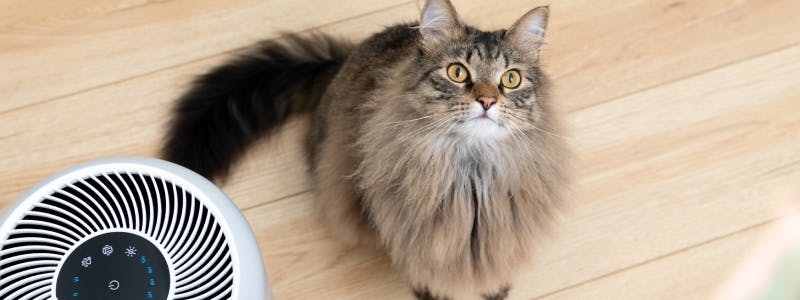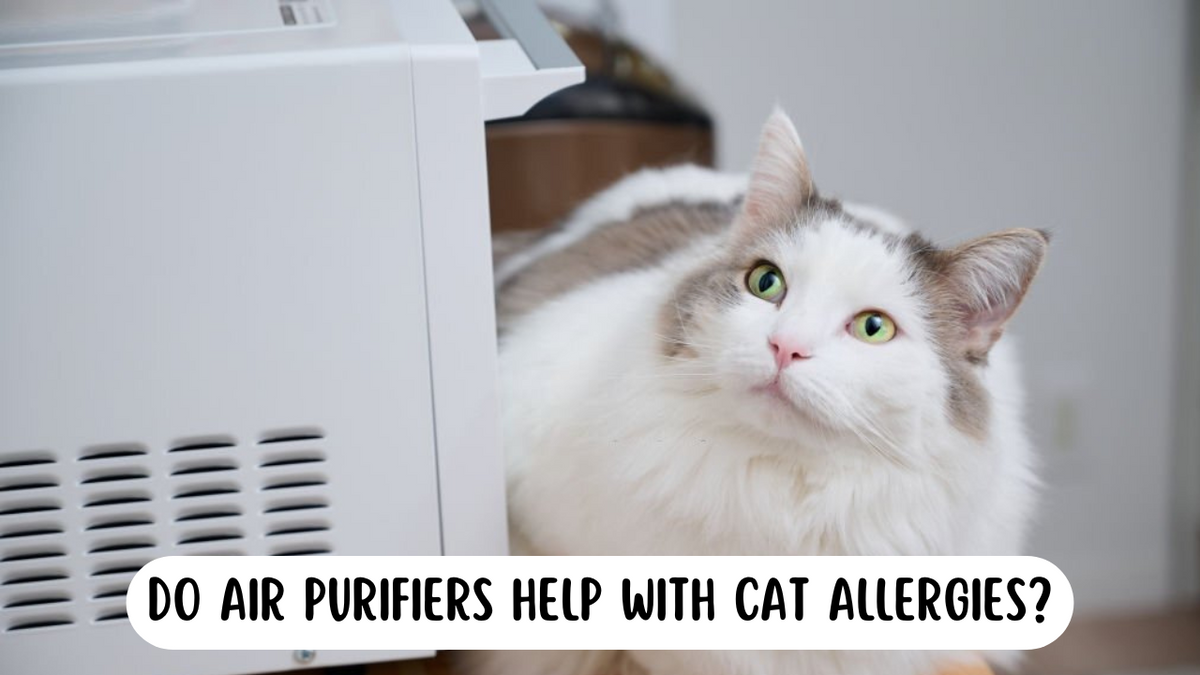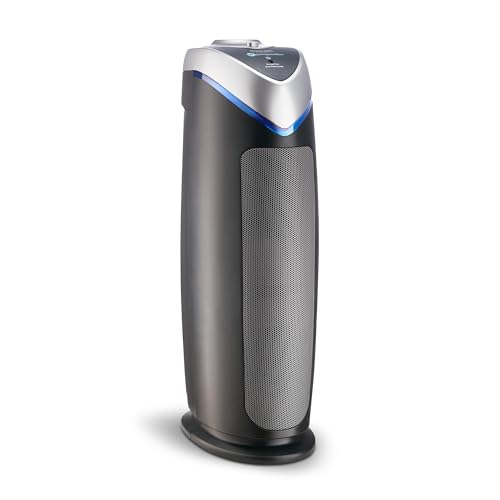Yes, an air purifier can help with cat allergies. It reduces allergens in the air, making breathing easier.
Living with a cat allergy can be challenging. Sneezing, itchy eyes, and constant discomfort can turn your home into an uncomfortable place. Many pet owners wonder if an air purifier could be the solution to this problem. Air purifiers are designed to filter out particles and pollutants from the air, including pet dander.
By removing these allergens, air purifiers can create a cleaner and more comfortable living environment. But how effective are they for cat allergies? In this blog post, we’ll explore how air purifiers work, their benefits, and whether they can truly make a difference for cat allergy sufferers.
You May Like
- WHY CHOOSE AHAM VERIFIDE AIR PURIFIERS: AHAM (Association of…
- HIGH-PERFORMANCE AIR PURIFICATION: Powerful 56W High-Torque…
- AHAM VERIFIDE FOR PROVEN PERFORMANCE:The Core 300-P is…
- GENUINE REPLACEMENT FILTERS: For the best performance and…
- HEPA Filter Air Purifier: Equipped with a protective True…
- A Breath of Fresh Air: A must-have air cleaner for homes,…
- Home-Focused Filtration: An ideal air purifier for bedrooms…
- Reliable Room Deodorizer: Equipped with an activated carbon…
- Suitable for Large Rooms:Air purifiers for home large room…
- Pet Owner’s Choice: The P280 air purifiers for home pets…
- Powerful washable filtration system: This H13 Hepa air…
- Quiet, Energy-Saving and Safe: This Bedroom air purifier…
- Impressive Particle Filtration: AROEVE air purifier utilizes…
- High Circulation Rate: With dual-channel and 360-degree air…
- Low Decibel Operation: AROEVE air purifier operates quietly,…
- Enjoy Fragrant Air: It features an aroma pad located below…
- MORE AIR INTAKE & HIGH-EFFICIENCY: This is the 2024 latest…
- AIR PURIFIER DESIGNED FOR PET LOVERS: This home pet air…
- DUST DETECTION & AIR QUALITY DISPLAY: This PR1 air purifiers…
- QUIET OPERATION & MULTI-FUNCTION: The air purifier for…

Credit: www.flonase.com
Introduction To Cat Allergies
Cat allergies can make life tough. Common symptoms include sneezing, itchy eyes, and a runny nose. Some people may also have skin rashes or trouble breathing. These symptoms can range from mild to severe. It is important to recognize these signs early. This helps in managing the allergy better.
Cat allergies are caused by proteins found in cat saliva, urine, and dander. Dander consists of tiny flakes of skin shed by cats. These proteins can stick to furniture, clothes, and other surfaces. When breathed in, they cause allergic reactions. Even short-haired cats can cause allergies. It is not the fur but the proteins that trigger symptoms.
How Air Purifiers Work
Air purifiers can help with cat allergies. They work by filtering the air. HEPA filters are the most common. They trap tiny particles. This includes pet dander. Some purifiers use activated carbon. This helps remove odors. UV light can kill germs and bacteria.
There are different types of air purifiers. HEPA air purifiers are very effective. They can trap 99.97% of particles. Activated carbon purifiers remove smells. Ionic purifiers release charged ions. These ions attach to particles. UV purifiers use light to kill germs. Each type has its benefits. Choose the one that fits your needs.
Effectiveness Of Air Purifiers For Allergies
Air purifiers can help with cat allergies. They remove pet dander from the air. Dander is tiny particles from a cat’s skin. These particles cause allergies. Air purifiers with HEPA filters are best. HEPA filters capture small particles. They remove most allergens from the air. This makes breathing easier.
Change the filter often. This keeps the air purifier working well. Place the air purifier in the room where the cat spends most time. Keep the doors and windows closed. This stops new allergens from entering.
Scientific studies support the use of air purifiers. They show a reduction in allergy symptoms. One study found that air purifiers reduce allergens by 50%. This can lead to fewer allergy attacks. Less sneezing, less itching, and less watery eyes. These benefits improve quality of life for allergy sufferers.

Credit: www.wellnessjunction.com
Choosing The Right Air Purifier
An air purifier can help reduce cat allergens in your home. It filters out dander and other airborne particles. This can lead to fewer allergy symptoms.
Key Features
Look for a HEPA filter. It captures tiny particles like cat dander. A carbon filter helps with odors. Check the CADR rating. It shows how well the purifier works. Noise level is important too. Some purifiers are too loud. Size matters. Choose one that fits your room. Maintenance is key. Easy-to-clean filters save time. Energy efficiency saves money.
Recommended Models
| Model | Key Features |
|---|---|
| Honeywell HPA300 | HEPA filter, large room coverage |
| Levoit LV-H132 | Compact, quiet, affordable |
| Dyson Pure Cool TP04 | HEPA filter, smart features, stylish |
Proper Placement Of Air Purifiers
Placing an air purifier in the right spot is key. Bedrooms are great places. This is because you spend a lot of time there. Living rooms are another good choice. Make sure there is enough space around the purifier. This helps it work better.
The size of the room matters a lot. Large rooms need bigger purifiers. Small rooms need smaller ones. Check the purifier’s coverage area. This is usually on the box. Match it to your room size. This ensures the purifier can clean the air well.

Credit: www.uahpet.com
Maintenance And Upkeep
Regularly changing the filter is crucial. Many air purifiers have HEPA filters. These need replacement every 6 to 12 months. Check the manual for exact timing. Some models have indicator lights. These lights tell you when to change the filter. A clean filter traps more allergens. This helps you breathe easier.
Cleaning the air purifier is necessary. Dust and dirt can build up. Wipe the exterior with a damp cloth. Do this every few weeks. Remove the filter and vacuum it. Do not use water on the filter unless the manual says so. Clean the inside parts too. This keeps your air purifier running well. A clean machine works better and lasts longer.
Additional Allergy-reducing Strategies
Clean your home often. Use a vacuum with a HEPA filter. This can remove pet dander. Wash your cat’s bedding weekly. Dust surfaces regularly. Use a damp cloth to avoid spreading allergens. Clean floors and carpets often. This helps reduce allergens.
Brush your cat daily. This can reduce shedding. Use a brush designed for pets. Bathe your cat monthly. Use a mild pet shampoo. This helps remove dander. Keep your cat’s fur short. Trim nails to reduce scratches. Clean ears to avoid infections. Healthy pets shed fewer allergens.
Frequently Asked Questions
Do Air Purifiers Help With Cat Allergies?
Yes, air purifiers can help reduce cat allergens. They capture pet dander, hair, and other particles. Choose a HEPA filter for best results.
Which Air Purifier Is Best For Cat Allergies?
HEPA air purifiers are best for cat allergies. They efficiently trap pet dander and other allergens. Choose one with a high CADR rating.
Can Air Purifiers Remove Cat Dander?
Yes, air purifiers can remove cat dander. HEPA filters are particularly effective. They capture even the smallest dander particles.
How Often Should I Use An Air Purifier For Cat Allergies?
Use an air purifier continuously for best results. Regular use helps maintain low levels of allergens. Clean or replace filters as recommended.
Conclusion
An air purifier can help reduce cat allergy symptoms. It removes allergens from the air. This includes pet dander and dust. Many people find relief using one. It complements other allergy management strategies. Regular cleaning and grooming your cat also help.
Remember, results may vary for each person. Consider trying an air purifier to see if it helps you. Making your home more comfortable is worth the effort.





